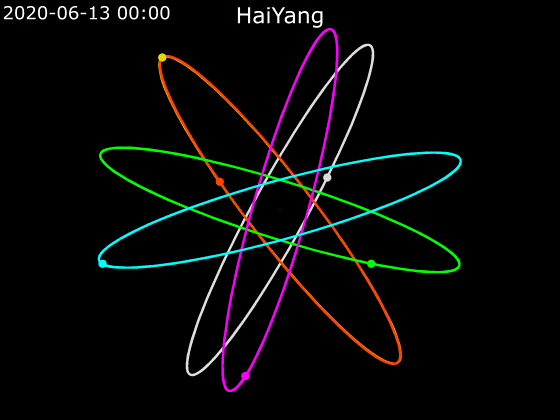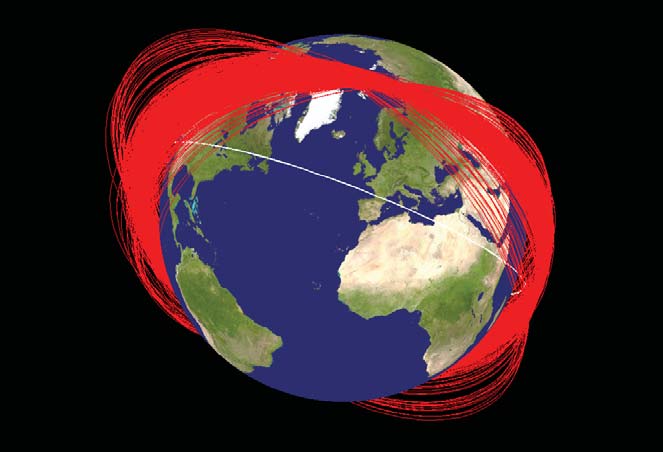|
Long March 4B
The Long March 4B (), also known as the Chang Zheng 4B, CZ-4B and LM-4B is a Chinese expendable orbital Launch vehicle. Launched from Launch Complex 1 at the Taiyuan Satellite Launch Center, it is a 3-stage launch vehicle, used mostly to place satellites into low Earth orbit and Sun-synchronous orbits. It was first launched on 10 May 1999, with the FY-1C weather satellite, which would later be used in the 2007 Chinese anti-satellite missile test. The Chang Zheng 4B experienced its only launch failure on 9 December 2013, with the loss of the CBERS-3 satellite. Launch Statistics List of launches See also * Long March 4C * Long March (rocket family) * Medium-lift launch vehicle A medium-lift launch vehicle (MLV) is a rocket launch vehicle that is capable of lifting between by NASA classification or between by Russian classification of payload into low Earth orbit (LEO).50t payloads" An MLV is between small-lift laun ... References {{Long March rockets ... [...More Info...] [...Related Items...] OR: [Wikipedia] [Google] [Baidu] |
CZ-4B
The Long March 4B (), also known as the Chang Zheng 4B, CZ-4B and LM-4B is a Chinese expendable orbital Launch vehicle. Launched from Launch Complex 1 at the Taiyuan Satellite Launch Center, it is a 3-stage launch vehicle, used mostly to place satellites into low Earth orbit and Sun-synchronous orbits. It was first launched on 10 May 1999, with the FY-1C weather satellite, which would later be used in the 2007 Chinese anti-satellite missile test. The Chang Zheng 4B experienced its only launch failure on 9 December 2013, with the loss of the CBERS-3 satellite. Launch Statistics List of launches See also * Long March 4C * Long March (rocket family) The Long March rockets are a family of expendable launch system rockets operated by the China Aerospace Science and Technology Corporation. The rockets are named after the Chinese Red Army's 1934–35 Long March military retreat during the Chi ... * Medium-lift launch vehicle References {{Long March rockets ... [...More Info...] [...Related Items...] OR: [Wikipedia] [Google] [Baidu] |
YF-40
The YF-40 is a Chinese liquid rocket engine burning N2O4 and UDMH in a gas generator cycle. It has dual gimbaling combustion chambers. Originally it was developed for the Long March 1D second stage. It is used on the third stage of the Long March 4 The Long March rockets are a family of expendable launch system rockets operated by the China Aerospace Science and Technology Corporation. The rockets are named after the Chinese Red Army's 1934–35 Long March military retreat during the Ch ... family of launch vehicles. References Rocket engines of China Rocket engines using hypergolic propellant Rocket engines using the gas-generator cycle {{rocket-stub ... [...More Info...] [...Related Items...] OR: [Wikipedia] [Google] [Baidu] |
CBERS-2
China–Brazil Earth Resources Satellite 2 (CBERS-2), also known as Ziyuan I-02 or Ziyuan 1B, was a remote sensing satellite operated as part of the China–Brazil Earth Resources Satellite program between the Chinese Center for Resources Satellite Data and Application and Brazilian National Institute for Space Research. The second CBERS satellite to fly, it was launched by China in 2003 to replace CBERS-1. CBERS-2 was a spacecraft built by the China Academy of Space Technology and based on the Phoenix-Eye 1 satellite bus. The spacecraft was powered by a single solar array, which provided 1,100 watts of electricity for the satellite's systems. The instrument suite aboard the CBERS-2 spacecraft consisted of three systems: the Wide Field Imager (WFI) produced visible-light to near-infrared images with a resolution of and a swath width of ; a high-resolution CCD camera was used for multispectral imaging at a resolution of with a swath width of ; the third instrument, the ... [...More Info...] [...Related Items...] OR: [Wikipedia] [Google] [Baidu] |
HY (satellite)
Haiyang (HY, ) is a series of marine remote sensing satellites developed and operated by the People's Republic of China since 2002. , eight satellites have been launched with ten more planned. Built by the state-owned aerospace contractor China Academy of Space Technology (CAST), Haiyang satellites carry a variety of ocean-imaging sensor payloads and are operated by the National Satellite Ocean Application Service (NSOAS), a subordinate agency of the State Oceanic Administration (SOA). Haiyang satellites are launched from Taiyuan Satellite Launch Center (TSLC) into sun-synchronous orbit (SSO) aboard Long March-series rockets. China's National Satellite Ocean Application Service owns three series of Haiyang-series satellites, Haiyang-1 (HY-1) are designed to measure ocean color, Haiyang-2 (HY-2) to study maritime environment dynamics, and Haiyang-3 (HY-3) to conduct ocean surveillance. Spacecraft Satellite bus The first three of a total four Haiyang 1-series satellites ... [...More Info...] [...Related Items...] OR: [Wikipedia] [Google] [Baidu] |
Ziyuan (satellite)
Ziyuan () is a series of remote sensing satellites operated by the People's Republic of China. Several Ziyuan satellites are operated jointly with Brazil's National Institute for Space Research under the China–Brazil Earth Resources Satellite program. Ziyuan satellites are based on the Phoenix-Eye-1 or Phoenix-Eye-2 satellite buses - the Phoenix-Eye-1 is used for CBERS missions while the Phoenix-Eye-2 is used for the remaining satellites. The Ziyuan-II series satellites are operated by the Chinese military. The Ziyuan-III series satellites are operated by the Ministry of Natural Resources An environmental ministry is a national or subnational government agency politically responsible for the environment and/or natural resources. Various other names are commonly used to identify such agencies, such as Ministry of the Environment, .... Satellites References {{CBERS Earth observation satellites of China Satellite series Spacecraft launched by Long March rocke ... [...More Info...] [...Related Items...] OR: [Wikipedia] [Google] [Baidu] |
SACI-1
The SACI-1 was a microsatellite of scientific applications, designed, developed, constructed and tested by Brazilian technicians, engineers and scientists working in INPE (National Institute of Space Research).Sousa, FabianoDesenvolvimento de satélites e plataformas espaciais no INPE no período 1961–2007 (PDF). INPE. Retrieved 31 March 2017. SACI-1 was launched on October 14, 1999, from the Taiyuan Satellite Launch Center, China, by means of a Long March 4B rocket, as a secondary payload at the CBERS-1 China–Brazil Earth Resources Satellite 1 (CBERS-1), also known as Ziyuan I-01 or Ziyuan 1A (ZY 1, ZY 1A), is a remote sensing satellite which was operated as part of the China–Brazil Earth Resources Satellite program between the China Nat ... launch. Features The "SACI" satellites are composed of a multi-mission platform and a set of experiments that constitute the payload. These satellites had the cooperation of several Brazilian and foreign institutions. The ... [...More Info...] [...Related Items...] OR: [Wikipedia] [Google] [Baidu] |
CBERS-1
China–Brazil Earth Resources Satellite 1 (CBERS-1), also known as Ziyuan I-01 or Ziyuan 1A (ZY 1, ZY 1A), is a remote sensing satellite which was operated as part of the China–Brazil Earth Resources Satellite program between the China National Space Administration and Brazil's National Institute for Space Research. The first CBERS satellite to fly, it was launched by China in 1999. CBERS-1 was a spacecraft built by the China Academy of Space Technology and based on the Phoenix-Eye 1 satellite bus. The spacecraft was powered by a single solar array, providing 1,100 watts of electricity for the satellite's systems. The instrument suite aboard the CBERS-1 spacecraft consisted of three systems: the Wide Field Imager (WFI) produced visible-light to near-infrared images with a resolution of and a swath width of ; a high-resolution CCD camera was used for multispectral imaging at a resolution of with a swath width of ; the third instrument, the Infrared Multispectral Sca ... [...More Info...] [...Related Items...] OR: [Wikipedia] [Google] [Baidu] |
Shijian
Shijian (, abbr. "SJ") is a series of satellites built and operated by the People's Republic of China. Some Shijian-series satellites have drawn significant concerns from the United States government and space observers who cite unannounced launches, undisclosed sub-satellites deployed in orbit, unusual orbital maneuvers, and demonstrated rendezvous proximity operations (RPO) including the close inspection and towing of other satellites. Little is known about the series and what differentiates it from other experimental satellite series launched by China such as the Chuangxin () series or Shiyan () series. The China Aerospace Studies Institute of the United States Air Force asserts that Shiyan-series satellites play an earlier role in the systems development process testing various new technologies on a single bus while Shijan-series satellites are used to develop operational best practices and optimize the technologies previously tested on Shiyan-series satellites. In this regar ... [...More Info...] [...Related Items...] OR: [Wikipedia] [Google] [Baidu] |
Fengyun
Fēngyún (FY, ) are China's meteorological satellites. Launched since 1988 into polar sun-synchronous and geosynchronous orbit, each three-axis stabilized Fengyun satellite is built by the Shanghai Academy of Spaceflight Technology (SAST) and operated by the China Meteorological Administration ( CMA). To date, China has launched nineteen Fengyun satellites in four classes (FY-1 through FY-4). Fengyun 1 and Fengyun 3 satellites are in polar sun-synchronous orbit while Fengyun 2 and 4 are geosynchronous orbit. On 11 January 2007 China destroyed one of these satellites (FY-1C, COSPAR 1999-025A) in a test of an anti-satellite missile. According to NASA, the intentional destruction of FY-1C created 2,841 high-velocity debris items, a larger amount of dangerous space junk than any other space mission in history. Classes Fengyun 1 The four satellites of the Fengyun 1 (or FY-1) class were China's first meteorological satellites placed in polar, sun-synchronous orbit. In this orbi ... [...More Info...] [...Related Items...] OR: [Wikipedia] [Google] [Baidu] |
CBERS-3
China–Brazil Earth Resources Satellite 3 (CBERS-3), also known as Ziyuan I-03 or Ziyuan 1D, was a remote sensing satellite intended for operation as part of the China–Brazil Earth Resources Satellite program between the Chinese Center for Resources Satellite Data and Application and Brazilian National Institute for Space Research. The fourth CBERS satellite to fly, it was lost in a launch failure in December 2013. Spacecraft CBERS-3 was a spacecraft based on the Phoenix-Eye 1 satellite bus. It was developed by the China Academy of Space Technology, in partnership with Brazil, at a cost of US$125 million for each party. The spacecraft had a single solar array which would have provided power to its systems, generating 2,300 watts of electrical power, and had a design life of three years. The CBERS-3 spacecraft carried four instruments: MUXCam, a multispectral camera; PanMUX, a panchromatic imager; the Infrared Medium Resolution Scanner, or IRSCAM, and WFICAM, a wide-f ... [...More Info...] [...Related Items...] OR: [Wikipedia] [Google] [Baidu] |
2007 Chinese Anti-satellite Missile Test
On 11 January 2007, China conducted an anti-satellite missile test. A Chinese weather satellite—the FY-1C (COSPAR 1999-025A) polar orbit satellite of the Fengyun series, at an altitude of , with a mass of —was destroyed by a kinetic kill vehicle traveling with a speed of in the opposite direction (see ''Head-on engagement''). It was launched with a multistage solid-fuel missile from Xichang Satellite Launch Center or nearby. ''Aviation Week & Space Technology'' magazine first reported the test on 17 January 2007. The report was confirmed on 18 January 2007 by a United States National Security Council (NSC) spokesperson.BBC News (2007)Concern over China's missile test Retrieved January 20, 2007. The Chinese government did not publicly acknowledge that the test had occurred until 23 January 2007 when the Chinese Foreign Ministry issued a statement confirming the test. China claims it formally notified the U.S., Japan and other countries about the test in advance. It was the fi ... [...More Info...] [...Related Items...] OR: [Wikipedia] [Google] [Baidu] |


